Speech Fundamentals and Flexibility
It is a pleasure for me to be able to speak at the CFA's Australia Investment Conference. I participated in the 2013 conference in Melbourne and it is very good to be back at your 2015 conference here in Sydney.
I would like to congratulate CFA Societies Australia for the topic that they have chosen for this year's conference: Going Back to Fundamentals. In a world in which the focus is too often on the short term, this conference serves as a timely reminder that it is the fundamentals that really matter.
In the area of finance, the CFA Institute has been playing a leading role in reinforcing the fundamentals of trust and fiduciary duty. Over recent years, we have seen too many examples around the world where not enough attention was paid to these fundamentals and, as a result, the reputation of the finance sector has been badly tarnished. The work of the CFA in promoting the highest standards of ethics and professional excellence is helping to return the focus on these fundamentals. This is important work and I wish you every success in it.
This morning, though, I would like to focus on a different set of fundamentals: that is, the fundamentals of the Australian economy.
My central message is that these fundamentals are strong and that they provide us with the basis to be optimistic about the future. At the same time, none of us has a crystal ball, so we can't be sure exactly what that future holds. What we can be sure of is that we will be best placed to take advantage of our strong fundamentals if our economy is flexible and if it is able to adapt to the changing world in which we find ourselves. Hence the title of my remarks this morning: Fundamentals and Flexibility.
Some Background
It is probably helpful to start with some context. This is usefully provided by this first graph, which shows various measures of how Australia's output and real income have evolved over the past couple of decades or so (Graph 1).
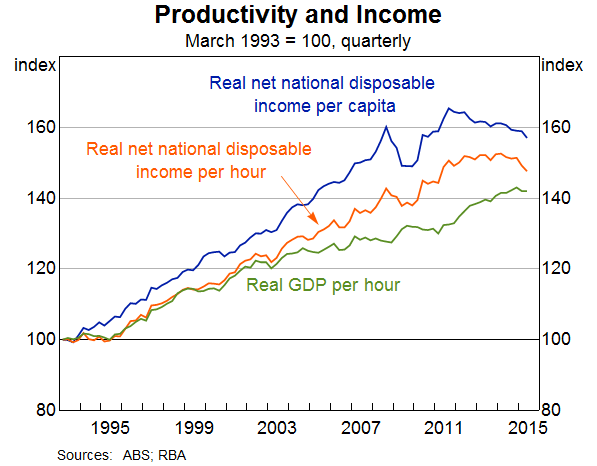
The green line shows output per hour worked. This is the conventional measure of labour productivity.
The orange line shows real income per hour worked.[1] In most countries, real output and income typically track one another quite closely and indeed this was the case for Australia during the 1990s. But over the 2000s, our real income increased much more quickly than our output owing to the large increase in our terms of trade. We became much better off as a nation because the prices of the goods that we were selling to the rest of the world increased quicker than the prices of the goods that we were buying from the rest of the world.
And, finally, the blue line shows real income, not per hour worked, but per person in Australia. This is probably the best measure of how average living standards have progressed through time: it takes into account the lift in productivity, changes in the relative prices of our exports and imports, and changes in the share of the population that is in paid employment. It is the strongest of the three lines shown here. This reflects the fact that over the past two decades or so there has been a substantial increase in the share of the population in paid employment; between 1993 and 2008, this share rose by 7 percentage points to over 50 per cent. This rise is accounted for by three trends: a decline in the unemployment rate, a rise in the participation rate and a decline in the share of children in the population (Graph 2).
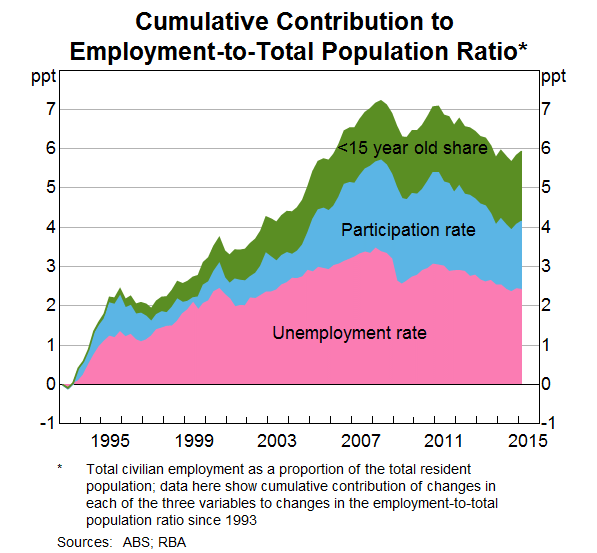
Taking these two decades or so as a whole, Australians have enjoyed very strong growth in average living standards. Real income per capita is currently around 60 per cent higher than it was in the early 1990s, having grown at an average rate of around 2 per cent per year over this long period. In the 1990s, we benefited from strong productivity growth. In the 2000s, we benefited from the rising terms of trade. And across both decades we benefited from increasing labour force participation and favourable demographic trends.
The story, over recent years, is a less positive one. While productivity growth has picked up a bit, the terms of trade have declined, as has the share of the population in employment. As a result, there has been very little growth in real income per capita since 2008. As is evident from Graph 1, this is quite different from the strong upward trend over the previous 15 years.
I suspect that it is this change that lies at the heart of some of the recent soul searching about the future of the Australian economy.
This soul searching is evident in the increasing number of people asking what comes next. What comes after the resources boom? Where will future growth in our living standards come from? Where will the jobs of the future be?
These are all excellent questions. They help focus our minds on the challenge ahead. And they can help promote better public policy. But we do need to be careful that the uncertainty that we feel about the future – and that is sometimes the undercurrent to these questions – does not mutate into chronic pessimism. If that were to happen, many of the opportunities that we do have are likely to go begging.
Looking to the future, it is unlikely that growth in our living standards will again come from a sustained lift in our terms of trade, which remain high in a historical context despite the falls of recent times (Graph 3). Of course, we cannot dismiss the possibility that we will be lucky again. But it would surely be unwise to hope for ever-rising export prices as the basis for improving our living standards.
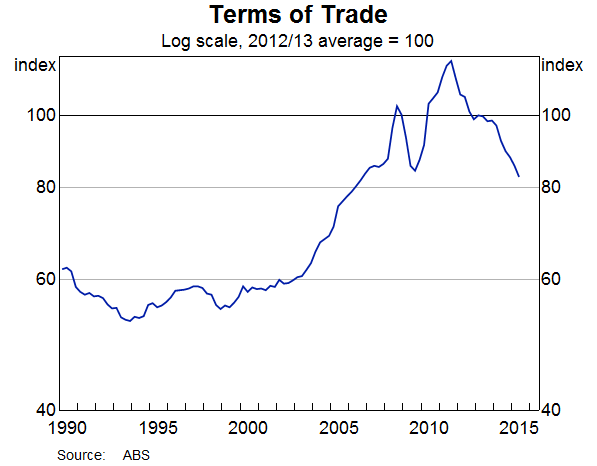
Similarly, with our population ageing, it seems unlikely that we will see a repeat of the large increase in the share of the population in paid employment.
Fundamentals
This leaves improving our productivity – the bottom line in Graph 1 – as the only alternative. And this is where our fundamentals matter. I have spoken about some of these fundamentals on other occasions, but it is worth highlighting some of these again today.[2] There are five in particular to which I would draw your attention.
The first is our strong institutional framework, including: the rule of law, respect for property rights, a well-functioning public administration and a well-established regulatory system. We can sometimes take these things for granted but, together, they form the bedrock upon which our high-income economy is built.
The second is our people. Our education system ranks reasonably highly by global standards. Australians generally have a ‘can do’ mentality and we have a demonstrated capability to adjust to a changing world. We adopt new technologies relatively quickly and many of us are prepared to take a risk. And we have successfully drawn people from all around the world to our shores, with more than 40 per cent of our population having been born overseas or having at least one parent who was born overseas.
The third is our tremendous base of mineral resources. Australia is fortunate to have some of the biggest and best-quality resource deposits on the planet. While the resources industry goes through large cycles, our resources continue to be in strong demand from the rest of the world. The export receipts from these resources effectively pay for many of the imports that we buy; over recent times these receipts have been equivalent to around half of Australia's annual import bill.
The fourth is our agricultural assets. As average incomes in Asia grow, so too does the demand for protein. Higher incomes also mean that there is a greater preparedness and ability to pay a premium price for high-quality, clean food. With our large tracts of agricultural land and the expertise built up from using that land over many decades, Australia has obvious advantages here.
And the fifth is our links with Asia and our expertise in delivering high-quality services. Over recent years, the focus has been very much on our relationship with China. This focus is likely to continue. But there are also significant opportunities elsewhere, including in Indonesia and India with their very large populations. Many of these opportunities lie in the services part of the economy, including in tourism, finance, education and professional services.
Together, this combination of fundamentals should provide us with confidence that we can continue to experience advances in our living standards. It is a combination of fundamentals that few other countries enjoy.
The Importance of Flexibility
In an ideal world, we might be able to take these fundamentals and map them into a clear path for the future. We might be able to say that these particular industries will thrive and these ones will not. That this is where the jobs of the future will come from. And that this is where we will find the success stories.
Unfortunately, the real world is not so simple. It is full of surprises and it is difficult to predict. Looking back over recent decades, the two factors that stand out as the main sources of this unpredictability are advances in technology and shifts in the global economy.
The advances in technology are reshaping, in unexpected ways, the jobs that we do. If we were to go back to 1995, or perhaps even to just 2005, I suspect that there are very few of us who could have imagined many of the new occupations that have emerged. There are big data architects, cloud computing experts, social media strategists, mobile app developers, information security technicians, green retrofit architects, genetic counsellors and the list goes on. Each of these new occupations is possible only because of advances in technology.
More broadly, the huge growth in employment in the services sector has taken many by surprise (Graph 4). Again, I suspect that if in the early 1990s we had known that there would be a net loss of over 100,000 jobs in the manufacturing sector in Australia over the next 25 years, there would have been a sense of despair about the future. This despair would probably have been compounded if we had also known there would be no growth in jobs in both the utilities and wholesale trade sectors over the next quarter of a century. Yet, over this period, we have enjoyed a strong rise in our living standards, the unemployment rate has come down substantially and we have generated around 4 million new jobs across the economy, mostly in the services sector.
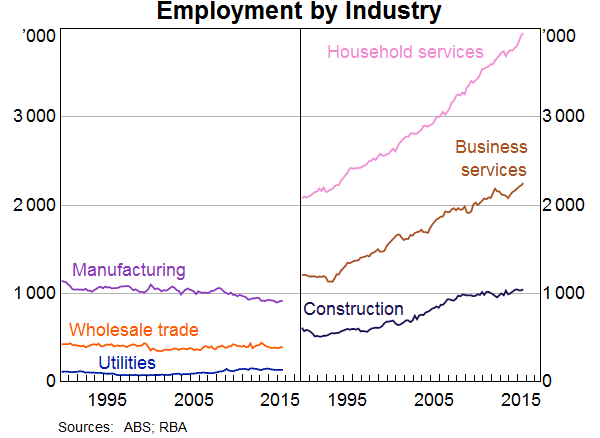
As I said, the other big source of unpredictability has been shifts in the global economy. You might recall that around the time of the Sydney Olympics there was much gnashing of teeth by those who saw Australia as an old economy, just selling resources to the rest of the world at ever-declining prices. We were seen by many to be locked out of the ‘new economy’ and destined for decline. At the time, few people saw the great opportunities that would come our way as a result of the emergence of China as a major force in the global economy.
One example of the difficulty of predicting change that I am fond of quoting comes from the conferences that the RBA organises every decade or so to provide a stocktake as to how our economy has evolved and the challenges ahead. In the volume published after the conference in 2000, the words ‘China’ and ‘Chinese’ do not appear a single time, but there were nearly one hundred references to the United States. In contrast, a decade later, in the volume published in 2011, there were nearly 300 references to China (with the number of references to the United States being similar to that in the 2000 volume).
A related example of the changes that can take place due to the shifts in the global economy is from the changing destination of Australia's exports. The very strong growth in the Japanese economy for some decades after World War II saw Japan become the major destination of our exports (Graph 5). Given this, if in the 1970s we had known what lay ahead for the Japanese economy, we might have been concerned about our own future. But as Japan slowed, exports to other parts of east Asia took off. And then, over recent years we have seen a third phase with the very strong growth of exports to China. None of these big shifts in our trade patterns was widely predicted.
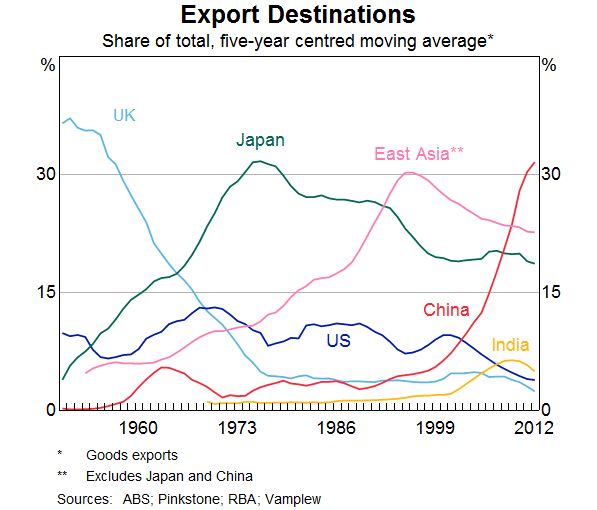
The point of these various examples is that, while we might wish for certainty about the future, it is not possible to have certainty. Technological progress is unpredictable and when it occurs it opens up possibilities that today we have trouble even imagining. And patterns in the global economy will no doubt continue to evolve. While we can hazard a guess about what this evolution might look like, the future does have a way of surprising us.
So the question is how we can best take advantage of our strong fundamentals in this world where it is difficult to predict the future.
A large part of the answer surely lies in ensuring that our economy has a high degree of flexibility. That it is adaptable and nimble. And that it can respond quickly to changes in relative prices and seize new opportunities brought about by advances in technology and shifts in the global economy.
There is no single policy lever though called ‘flexibility’ or ‘adaptability’. The degree of flexibility of the economy is the result of the accumulation of numerous decisions and policies across many, many areas.
In the area directly related to the central bank, the flexibility of the exchange rate is a key element. For more than three decades now our floating exchange rate has, arguably, been the single most stabilising influence on our economy. It has helped us deal with very large global shocks and it continues to do. In particular, the depreciation over the past couple of years is playing an important role in helping the economy adjust to the wind-down of the boom in mining investment.
Another area critical to flexibility is the financial sector, as it provides the resources businesses need to expand as new opportunities emerge. While Australia has been well served by its financial institutions and markets over many years, we need to make sure the regulatory environment remains conducive to new forms of finance that can help fund innovation and the development of new ideas. The recent work by the Australian Government to facilitate crowd-sourced equity funding is a step in this direction.[3] Here, the challenge is to get the balance right between funding innovation and protecting investors.
Most of the areas, though, that affect the flexibility of the economy lie beyond the world of central banks and finance. I would like briefly to mention four of these.
The first is the competitive environment in which firms operate. Where competition is robust and entry to markets is easy, businesses have a stronger incentive to find better ways of doing things. They also have a stronger incentive to move quickly, lest a competitor seize an opportunity before they do. I think it is fair to say that few businesses really like competition, but, often, it is competition that drives them to do better and respond to new opportunities. And competition benefits us all as consumers, bringing new and lower-cost goods and services to market. So, we need a regulatory environment that is conducive to new entry, including by those who are able to harness new technologies to reinvent how things are done.
A second area is the nature of the incentives to innovate and to start new businesses. These incentives are affected by the tax system and the regulatory and legal systems. They are also affected by the general community attitude to risk taking. We will be better placed to take advantage of the opportunities made possible by our strong fundamentals if our culture is one that accepts risk and appropriately rewards risk taking.
A third area is the operation of the labour market. From a macroeconomic point of view, Australia's labour market arrangements have worked well over recent times. During the global downturn, flexibility in hours worked helped limit the rise in unemployment. Then, during the years of the resources boom, very large wage increases were mainly confined to the areas where skills were in the shortest supply and they did not spread across the economy as a whole. And more recently, the slowing in aggregate wage growth has helped employment to grow reasonably strongly despite below-average growth in the overall economy (Graph 6). So, from a cyclical perspective, the labour market has proved to be quite flexible and things have worked reasonably well.

A more open question is the degree of flexibility in dealing with structural change. Again, we are more likely to be able to capitalise on our strong fundamentals if our system of workplace relations helps businesses and their employees respond quickly and effectively to new opportunities. This is especially so when business models and the preferred working patterns of Australians are changing. As the Productivity Commission's recent draft report on Australia's framework for workplace relations concludes, it should be possible to simplify and improve the responsiveness of our current system while, at the same time, addressing the sometimes unequal bargaining positions in the labour market.[4]
And the fourth area is the nature of our education system. No matter what the future holds, it seems probable that continual improvement in our human capital will hold us in good stead. But given the unpredictability of the world in which we live, we need to find the right balance between the development of specific technical and professional skills and the general cognitive skills that are central to flexibility and adaptability.
In each of these four areas – competition policy, the reward for innovation, the industrial relations system and the education system – the choices that we make are critical to the flexibility of the economy.
I want to conclude by noting that I have not mentioned interest rates once today. That is not because they are unimportant! The RBA's monetary policy plays a key role in dealing with cyclical swings in the economy. We aim to keep inflation low and stable so that people can go about their business without having to worry about large movements in the general level of prices. And our actions help promote stability in Australia's overall economy and its financial system. These are all important contributions.
But, ultimately, the rate at which our living standards improve is unlikely to be driven by the actions of the central bank. Instead, the improvement in our living standards rests on our ability to improve our fundamentals and enhance the flexibility of our economy so that it can take full advantage of the opportunities in our ever-changing world.
I wish you all success today in your own deliberations about fundamentals and I would be happy to answer any questions.
Thank you.
Endnotes
I would like to thank Adam Cagliarini for assistance in the preparation of these remarks. [*]
The measure of income used here is Real Net National Disposable Income (RNNDI). It adjusts Gross Domestic Product (GDP) to take account of changes in the prices of our exports relative to our imports (the terms of trade effect), real income flows between Australia and the rest of the world, and depreciation of machinery, buildings and other produced capital. [1]
See Lowe P (2014), ‘Building on Strong Foundations’, Address to the Australian Business Economists Annual Dinner, Sydney, 25 November. [2]
See, for example, Australian Government (2015), Facilitating Crowd-sourced Equity Funding and Reducing Compliance Costs for Small Businesses, Consultation Paper, The Treasury. Available at <http://www.treasury.gov.au/~/media/Treasury/Consultations%20and%20Reviews/Consultations/2015/Crowd-sourced%20equity%20funding/Key%20Documents/PDF/Crowd-sourced-equity-funding.ashx> [3]
See Productivity Commission (2015), Workplace Relations Framework, Draft Report, Canberra. Available at <http://www.pc.gov.au/inquiries/current/workplace-relations/draft/workplace-relations-draft.pdf> [4]
